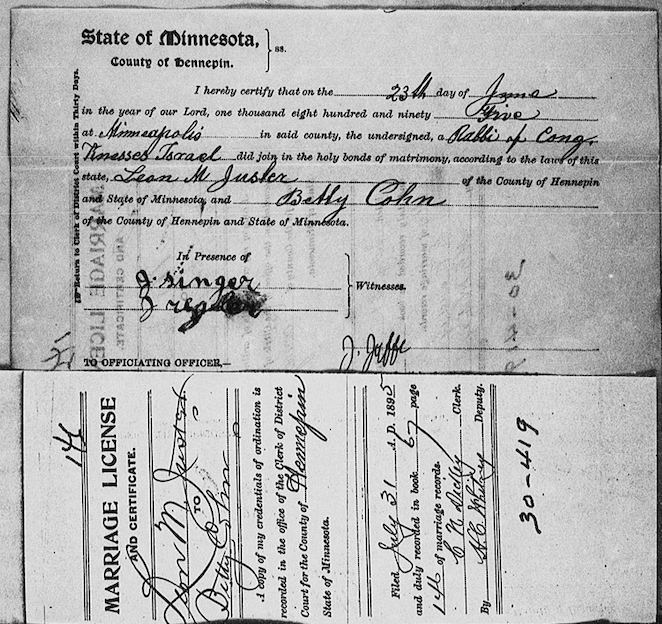
This article was originally published in Hennepin History Magazine, 2022, Vol. 81, No. 3
A vital source for genealogy research
by Susan Weinberg
Vital records are an important resource to a genealogist. That’s a broad catch-all term for birth, marriage, and death records — the vital events in a person’s life. They help us validate the linkages between children, siblings, parents, and grandparents.
Marriage records are usually the most valuable because they frequently list the names of the parents of both spouses. Additionally, you have the advantage of the two participants being alive and able to communicate first-hand knowledge resulting in greater accuracy. New York records, which we discussed in the last issue (Vol. 81, No. 2, 2022), provide parents’ names for both participants as do many states and overseas records. Unfortunately, the earlier marriage records in Minnesota do not, so their main value is in verifying both the maiden and married name of the bride.
Researchers frequently want to find parents’ names to work back another generation. Death certificates are a significant resource. Most will have the father’s name, and you may be lucky enough to get the mother’s maiden name. Death records are also useful if you are trying to find siblings. A copy of each person’s death record will help confirm relationships by matching the parents.
The information in a death record is only as good as the knowledge of the person who provided it, so take note of who that is. A spouse from the same European town may be able to give more accurate information about parents and the town of origin than a child who has never been there or met his grandparents. And you may find that parents’ names are Americanized even if they never set foot in the United States. My great-great- grandfather’s name reads Pesach Mordechai on his son’s tombstone. On his son’s death certificate, Pesach Mordechai was reported as Peter Max.
While New York noncertified vital records are online, in many states we are not quite as fortunate and will need to contact the specific state to obtain a copy. The National Center for Health Statistics provides information on how to locate records for individual states at tinyurl.com/38xb4tfd.
Birth and death indices
So where do we find these documents in Minnesota? For genealogical purposes we are usually looking for a noncertified copy. The search begins at the Minnesota Historical Society and much of it can be conducted online. Go to mnhs.org where you will see a dropdown under Research. Go to Minnesota People Records Search. There you will find birth indices for 1900 through 1934 and death indices for 1904 through 2001. Now enter a name into the search field. Scroll down to the bottom of the page and click on birth records. There you will find birth dates, related names (usually mother’s maiden name), county, and a certificate number. Similarly, you can click on death records and find the death date, county, and a certificate number. Death records often provide the parents’ names and country or town of origin as well as the spouse, birth date, cause of death, and the cemetery in which they are buried.
You may find the data from the index is sufficient for your needs, but perhaps you want to verify the parents of a decedent. With those certificate numbers you can purchase a noncertified copy of the original birth or death documents through the Minnesota Historical Society for $9. Alternatively, you can locate the death record on microfilm yourself and print or scan it at the Gale Library located on the second story of the Minnesota History Center. This may be well worth the trip if you need several records. Also, in the Hubbs Microfilm Room you will find microfilm copies of newspapers throughout Minnesota so you can follow up your search with a search for an obituary. It is all self-service with a librarian available to assist as necessary.
Marriage records
Marriage records can be easily accessed through moms.mn.gov where you can enter the names to pull up an index of what is available. You can purchase a record for $9 through the site or go to familysearch.org where you can pull up the original application or certificate. There you can access the Minnesota County Marriages from 1860 to 1949: familysearch.org/search/collection/1803974.
If you see an icon for a camera, you can click on it to pull up an image of the related document.
From birth to marriage to death, we can trace the trajectory of a person’s life and its many interconnections with the lives of others.
Susan Weinberg is a writer, artist, and genealogist, and frequently speaks on topics related to genealogy and artwork. She’s president of the Minnesota Jewish Genealogical Society (MNJGS.org) and serves on the boards of the International Association of Jewish Genealogical Societies (IAJGS.org) and the Jewish Historical Society of the Upper Midwest (JHSUM.org). She creates art in her studio in the California Building in Northeast Minneapolis. For more information, visit studio409art.com or her book site, wespokejewish.com.
Watch a presentation Susan gave for Hennepin History Museum about her methodology for unraveling challenging genealogical stories at youtu.be/7x5eD98BlNw.
